If you had told Wall Street tech stalwarts back in 2020 that Intel (NYSE:INTC) stock would plummet as rapidly as it has over the last 12 months, it’s likely many of them would have laughed you off. Fast forward four years, and Intel is in the same position it was over two decades ago.
Furthermore, the company recently announced sweeping layoffs as a form of cost-cutting in the face of its significant chipmaking losses. These factors are particularly discouraging considering the headstart Intel had as the prime central processing unit manufacturer in America.
At one point, the company was renowned for the high-temperature efficiency and processing power of its chips and had maintained several U.S.-based foundries even after the mass exodus of manufacturing to China. Yet with its legacy and its price now so low, the question becomes can Intel stage a comeback, and if it can what would it take for it to rise to prominence again?
An Architectural Shift in the Industry
Although it seems like Intel’s decline happened overnight as the result of a few quarterly earnings misses and significant operational losses, the plummeting value experienced today is the result of a gradual shift in the computing architecture and industry paradigm. For decades, Intel was the dominant designer and producer of CPUs built on what is known as x86 architecture.
This family of complex instruction set computer architectures was originally developed by Intel, and it was indeed introduced in 1978 enabling the first 16-bit software to be designed around its new processing power. To this day, this design is still dominant in desktop computers and laptops, while ARM (NASDAQ:ARM)-designed chips make up the central processing capabilities of smartphones and tablets.
However, ARM architecture has begun to overtake x86 in popularity for AI laptops, such as all of the new Mac computers that use M1 chips and newer ones because ARM architecture chips are far more energy efficient, producing less heat when running calculations critical to maintaining the computer systems. This makes them perfect for devices with smaller batteries that still need to last a long time. As ARM-designed chips grow in popularity, so too will software designed for the front of architecture, which will slowly erode Intel’s x86 architecture relevance.
Foundry Failures
When looking at it this way, it seems like the natural course of technological advancement is simply leaving Intel behind. Yet, x86 architecture still commands higher processing power for cheaper, meaning it will always have applications in calculation-intensive devices, such as gaming PCs and government computer systems.
However, even with this weakening moat, Intel’s largest turn-off to investors is its current cash bleed as a result of a floundering foundry division. This division should have made it a dominant domestic producer of critical semiconductors and microchips. With many of its operational losses, stemming from this section in particular, Intel will need to recruit the best of the best process engineers, to improve its production trajectory or close it entirely.
Even with investor sentiment set aside, the $ 7 billion lost on the assembly line and production floor at Intel foundries have broad ripple effects through the supply chains of their customers. That’s because high scrap rates greatly increase the cost of the critical programs, which Intel foundries support.
No Good Reasons to Buy for Now
The bottom line for investors looking to secure a position in Intel stock is accepting the reality that Intel may have further to fall before it can turn things around. That’s because both current problems it faces are rapidly decreasing – its share value or not quick fixes.
No amount of layoffs or even closures is going to change the fact that entails dominance over computer architecture is waning and its production efficiency makes it an unattractive supplier to the very agencies that clamored for more domestic semiconductor manufacturing.
As a result, the best recommendation for Intel stock is to hold. Whether you own, or are considering buying the stock, waiting before increasing your position is likely the best way to avoid further dramatic drop-offs in share value as the company repositions itself both from a technological and operational standpoint.
On the date of publication, Viktor Zarev did not have (either directly or indirectly) any positions in the securities mentioned in this article. The opinions expressed in this article are those of the writer, subject to the InvestorPlace.com Publishing Guidelines.
On the date of publication, the responsible editor did not have (either directly or indirectly) any positions in the securities mentioned in this article.

